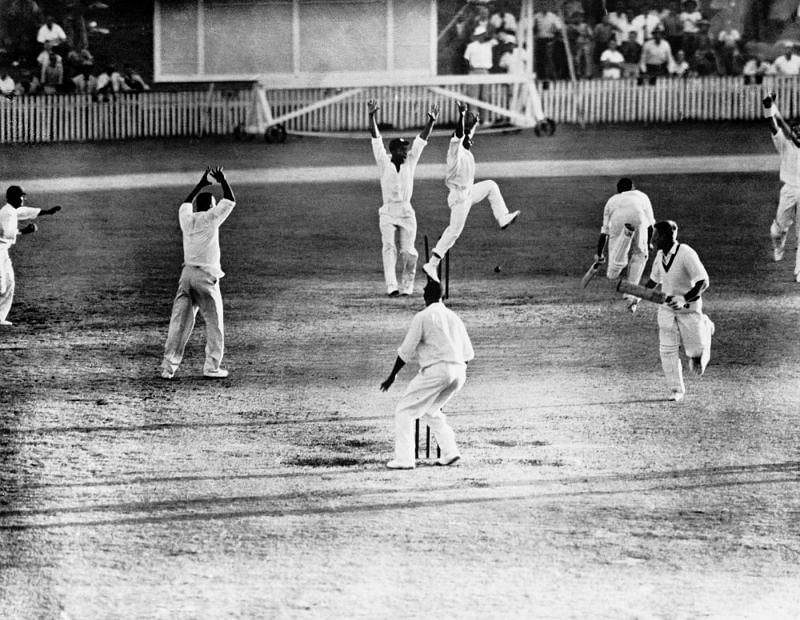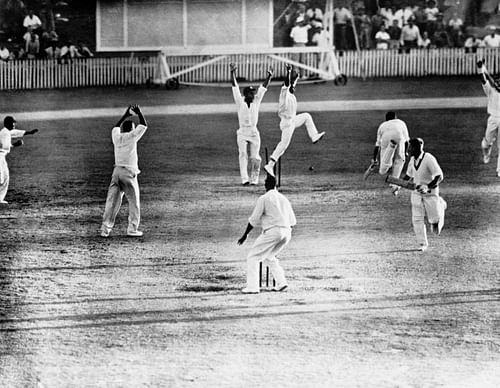
The story behind the iconic photograph that captured the dying moments of the first Tied Test

In 2000, ace cricket photographer Patrick Eagar was asked by the then editor of Wisden Cricketers' Almanack to pick ten iconic images from the 20th century ( one from each decade). It was a tough assignment. There were only two 'easy' entries: Victor Trumper's iconic imaged captured by George Beldam (1900s) and the image which captured Don Bradman being dismissed by Eric Hollies for a duck in his final Test at The Oval (1940s). The other eight were not that straightforward.
The competition for top spot in the 1960s was narrowed down to two images: Dennis Oulds of Central Press capturing all eleven from the England team surrounding the last Australian batsman at the Oval Test match of 1968 and Ron Lovitt capturing the final act from the first tied Test in cricket's long and illustrious history.
Eagar voted in favour of Lovitt's capture. It was adjudged as the most iconic cricket picture from the 1960s. In fact, it is perhaps one of the top five cricket pictures ever taken.
Ron Lovitt gained fame as a photographer during the 1950s. He had undertaken two major assingments in that decade: one to Japan in 1951-52 and the other to New Guinea in 1956-57. Despite all his exploits in faraway lands, Lovitt's real fame lies in capturing one of the most iconic images in the history of Australain sports.
In this famous picture one can see Joe Solomon at the far left, completing one of the most important run outs in cricket's history. Ian Meckiff is short of his ground as his partner Lindsay Kline looks back. The trigger was pulled at the right time, thus making Lovitt a part of cricket's folklore.
Ron Lovitt didn't have the best of days leading up to the final over of the match. Six runs were required off eight balls. Lovitt, Harry Martin from Sydney Morning Herald and Bobby Barnes from The Courier-Mail, Brisbane all found that they were running out of films when Wes Hall prepared to bowl the first ball of the final over.
There are a couple of legends about how the three photographers struck deals among them to share the 'burden' during the final over. One states that adversaries Lovitt and Martin tossed a coin to decide who would pull the trigger to capture the seventh delivery of the over.
The other legend says that Lovitt had only one negative left when Hall started that over. Barnes had six left. They decided to pool their resources and Barnes, with more in the bag, was the first mover.
As Hall began that over, Lovitt had actually shot his 24 frames for the day. But in his camera bag there was a double dark slide which could work with his Speed Graphic 5 x 4 camera. He had used the side earlier in the day when he was requested by the news desk to get a picture of Queensland governor Sir Henry Abel Smith who was present at the ground. But he made a blunder after clicking the photo of the governor- he didn't mark the side with which he had clicked the governor's photo.
He backed his luck as he put the slide back into the camera. It was surely the greatest risk of his professional career. He is believed to have turned to Barnes and say, " Bobby, if nothing happens with this ball I'm going to get hung, drawn and quartered. I haven't taken a picture yet!"
Then he captured this photo by pulling the trigger in the right split second. It could not have been taken in a better way.
As the crowd rejoiced the end of a remarakble Test match, Lovitt nervously returned to his office to process the 24 negatives and the two from the double dark slide. Then only he discovered what he had done. His faith in luck had paid off!
The rest is history.